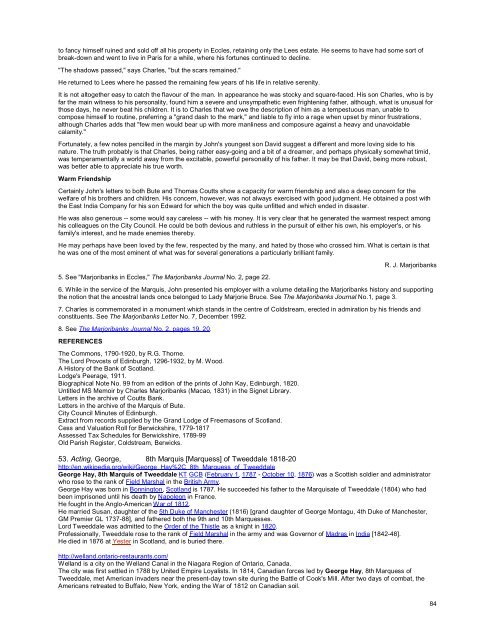Grand Masters of Scotland - Onondaga and Oswego Masonic ...
Grand Masters of Scotland - Onondaga and Oswego Masonic ...
Grand Masters of Scotland - Onondaga and Oswego Masonic ...
You also want an ePaper? Increase the reach of your titles
YUMPU automatically turns print PDFs into web optimized ePapers that Google loves.
to fancy himself ruined <strong>and</strong> sold <strong>of</strong>f all his property in Eccles, retaining only the Lees estate. He seems to have had some sort <strong>of</strong><br />
break-down <strong>and</strong> went to live in Paris for a while, where his fortunes continued to decline.<br />
"The shadows passed," says Charles, "but the scars remained."<br />
He returned to Lees where he passed the remaining few years <strong>of</strong> his life in relative serenity.<br />
It is not altogether easy to catch the flavour <strong>of</strong> the man. In appearance he was stocky <strong>and</strong> square-faced. His son Charles, who is by<br />
far the main witness to his personality, found him a severe <strong>and</strong> unsympathetic even frightening father, although, what is unusual for<br />
those days, he never beat his children. It is to Charles that we owe the description <strong>of</strong> him as a tempestuous man, unable to<br />
compose himself to routine, preferring a "gr<strong>and</strong> dash to the mark," <strong>and</strong> liable to fly into a rage when upset by minor frustrations,<br />
although Charles adds that "few men would bear up with more manliness <strong>and</strong> composure against a heavy <strong>and</strong> unavoidable<br />
calamity."<br />
Fortunately, a few notes pencilled in the margin by John's youngest son David suggest a different <strong>and</strong> more loving side to his<br />
nature. The truth probably is that Charles, being rather easy-going <strong>and</strong> a bit <strong>of</strong> a dreamer, <strong>and</strong> perhaps physically somewhat timid,<br />
was temperamentally a world away from the excitable, powerful personality <strong>of</strong> his father. It may be that David, being more robust,<br />
was better able to appreciate his true worth.<br />
Warm Friendship<br />
Certainly John's letters to both Bute <strong>and</strong> Thomas Coutts show a capacity for warm friendship <strong>and</strong> also a deep concern for the<br />
welfare <strong>of</strong> his brothers <strong>and</strong> children. His concern, however, was not always exercised with good judgment. He obtained a post with<br />
the East India Company for his son Edward for which the boy was quite unfitted <strong>and</strong> which ended in disaster.<br />
He was also generous -- some would say careless -- with his money. It is very clear that he generated the warmest respect among<br />
his colleagues on the City Council. He could be both devious <strong>and</strong> ruthless in the pursuit <strong>of</strong> either his own, his employer's, or his<br />
family's interest, <strong>and</strong> he made enemies thereby.<br />
He may perhaps have been loved by the few, respected by the many, <strong>and</strong> hated by those who crossed him. What is certain is that<br />
he was one <strong>of</strong> the most eminent <strong>of</strong> what was for several generations a particularly brilliant family.<br />
5. See "Marjoribanks in Eccles," The Marjoribanks Journal No. 2, page 22.<br />
R. J. Marjoribanks<br />
6. While in the service <strong>of</strong> the Marquis, John presented his employer with a volume detailing the Marjoribanks history <strong>and</strong> supporting<br />
the notion that the ancestral l<strong>and</strong>s once belonged to Lady Marjorie Bruce. See The Marjoribanks Journal No.1, page 3.<br />
7. Charles is commemorated in a monument which st<strong>and</strong>s in the centre <strong>of</strong> Coldstream, erected in admiration by his friends <strong>and</strong><br />
constituents. See The Marjoribanks Letter No. 7, December 1992.<br />
8. See The Marjoribanks Journal No. 2, pages 19, 20.<br />
REFERENCES<br />
The Commons, 1790-1920, by R.G. Thorne.<br />
The Lord Provosts <strong>of</strong> Edinburgh, 1296-1932, by M. Wood.<br />
A History <strong>of</strong> the Bank <strong>of</strong> <strong>Scotl<strong>and</strong></strong>.<br />
Lodge's Peerage, 1911.<br />
Biographical Note No. 99 from an edition <strong>of</strong> the prints <strong>of</strong> John Kay, Edinburgh, 1820.<br />
Untitled MS Memoir by Charles Marjoribanks (Macao, 1831) in the Signet Library.<br />
Letters in the archive <strong>of</strong> Coutts Bank.<br />
Letters in the archive <strong>of</strong> the Marquis <strong>of</strong> Bute.<br />
City Council Minutes <strong>of</strong> Edinburgh.<br />
Extract from records supplied by the <strong>Gr<strong>and</strong></strong> Lodge <strong>of</strong> Freemasons <strong>of</strong> <strong>Scotl<strong>and</strong></strong>.<br />
Cess <strong>and</strong> Valuation Roll for Berwickshire, 1779-1817<br />
Assessed Tax Schedules for Berwickshire, 1789-99<br />
Old Parish Register, Coldstream, Berwicks.<br />
53. Acting, George, 8th Marquis [Marquess] <strong>of</strong> Tweeddale 1818-20<br />
http://en.wikipedia.org/wiki/George_Hay%2C_8th_Marquess_<strong>of</strong>_Tweeddale<br />
George Hay, 8th Marquis <strong>of</strong> Tweeddale KT GCB (February 1, 1787 - October 10, 1876) was a Scottish soldier <strong>and</strong> administrator<br />
who rose to the rank <strong>of</strong> Field Marshal in the British Army.<br />
George Hay was born in Bonnington, <strong>Scotl<strong>and</strong></strong> is 1787. He succeeded his father to the Marquisate <strong>of</strong> Tweeddale (1804) who had<br />
been imprisoned until his death by Napoleon in France.<br />
He fought in the Anglo-American War <strong>of</strong> 1812.<br />
He married Susan, daughter <strong>of</strong> the 5th Duke <strong>of</strong> Manchester (1816) [gr<strong>and</strong> daughter <strong>of</strong> George Montagu, 4th Duke <strong>of</strong> Manchester,<br />
GM Premier GL 1737-88], <strong>and</strong> fathered both the 9th <strong>and</strong> 10th Marquesses.<br />
Lord Tweeddale was admitted to the Order <strong>of</strong> the Thistle as a knight in 1820.<br />
Pr<strong>of</strong>essionally, Tweeddale rose to the rank <strong>of</strong> Field Marshal in the army <strong>and</strong> was Governor <strong>of</strong> Madras in India [1842-48].<br />
He died in 1876 at Yester in <strong>Scotl<strong>and</strong></strong>, <strong>and</strong> is buried there.<br />
http://well<strong>and</strong>.ontario-restaurants.com/<br />
Well<strong>and</strong> is a city on the Well<strong>and</strong> Canal in the Niagara Region <strong>of</strong> Ontario, Canada.<br />
The city was first settled in 1788 by United Empire Loyalists. In 1814, Canadian forces led by George Hay, 8th Marquess <strong>of</strong><br />
Tweeddale, met American invaders near the present-day town site during the Battle <strong>of</strong> Cook's Mill. After two days <strong>of</strong> combat, the<br />
Americans retreated to Buffalo, New York, ending the War <strong>of</strong> 1812 on Canadian soil.<br />
84







![Richard [Nicholls] Harison / Harrison - Onondaga and Oswego ...](https://img.yumpu.com/24950065/1/190x245/richard-nicholls-harison-harrison-onondaga-and-oswego-.jpg?quality=85)

![Richard [Nicholls] Harison / Harrison - Onondaga and Oswego ...](https://img.yumpu.com/24950063/1/190x245/richard-nicholls-harison-harrison-onondaga-and-oswego-.jpg?quality=85)







